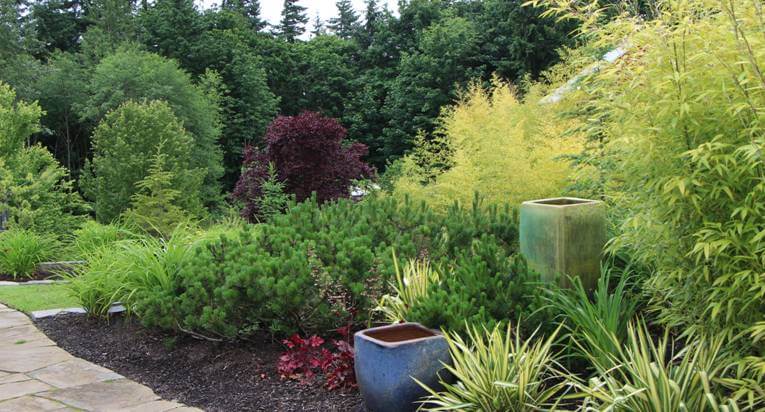
It’s your choice of plants and materials and the way you care for your garden that make it sustainable, not the style.
Happy Earth Day!
This month, in honor of our 30th anniversary and Earth Day, we’re exploring common myths about sustainable gardening. Here is myth #4: “Sustainable gardens are not my style.”
Busting the style myth
A lot of people think that sustainable gardens look a certain way. Perhaps they imagine a desert landscape made up of rocks, succulents and cactus. Or they might think about a forest filled with native trees, shrubs and ferns with very few colorful flowers. Some picture rain gardens as a soggy dip in the lawn with a few scraggly plants.
Sustainable gardening is about your choices
It’s the care you give your soil, the plants you select, the way you maintain your garden and the materials you use that make a garden sustainable. The style? That’s totally up to you. Whether you love a formal, cottage, contemporary or eclectic look, you can make it sustainable.
As In Harmony co-owner Mark Gile put it, “A well-designed drought-tolerant landscape can be filled with a lush variety of colorful plants that look beautiful all year—and you’d never guess it was created to save water and avoid chemical use.”
Sustainable garden tips
1. Choose drought-tolerant plants
For sunny, dry spots, pick plants that don’t need much water. There are many options that mimic the look and color of traditional favorites. Check out greatplantpicks.org for ideas, inspiration and useful plant lists.
2. Choose plants that thrive in local conditions
Reduce the need for pesticides by choosing plants that grow well in Pacific Northwest weather and soil conditions. Natives are great, but there are plenty of other options. Greatplantpicks.org is a wonderful resource.
3. Support local wildlife
Select plants that offer food and shelter for birds, butterflies, bees and other wildlife. It’s easy to help wildlife while keeping your garden beautiful. Read more about helping wildlife in your landscape.
4. Grow some edibles
Mix in fruits, herbs or veggies among your ornamentals. It’s a fun way to feed yourself and your family, and perhaps share with your neighbors or a local food bank. Read how to add edible plants to your landscape.
5. Go green with your hardscapes
When making patios or paths, let rainwater soak into the ground by using permeable pavers or leaving spaces between pavers. Look for salvaged concrete, brick or stone. Build paths from gravel or nutshells. Read more about sustainable landscape materials.
6. Rethink your lawn
Do you really need a big lawn to maintain? Shrink it down to just what you use, and explore lawn alternatives that don’t require as much water, fertilizer or weed killers.
7. Use sustainable care practices
- Fertilize wisely. Apply fertilizer only when plants need it, follow the application rates found on the package, and switch to organic fertilizers.
- Pull weeds by hand or spot treat them. A good tool makes weeding easier, and a thick layer of mulch is the best weed prevention.
- Use least-toxic pest controls only when the plant shows damage. Read more about safe ways to manage pests.
8. Use organic mulch
Top off garden beds with compost, untreated wood chips or aged manure. Avoid synthetic or dyed mulches. Read more about how to use mulch in your yard. Mulch has many benefits:
- Conserves water
- Greatly suppresses weeds
- Feeds beneficial soil life
- Helps plants survive harsh conditions, such as winter rainstorms and summer heat
Our experienced landscape designers and installers can help you create a more sustainable yard and garden, whether you are starting from scratch with a new landscape or updating an existing landscape.
No matter your taste or garden style, you can create a beautiful, sustainable space that’s uniquely yours. Happy gardening!

Great information!!
Thanks! We’re glad you found it helpful.